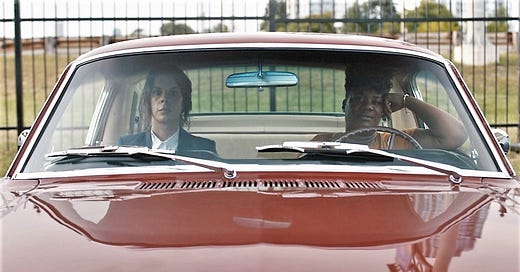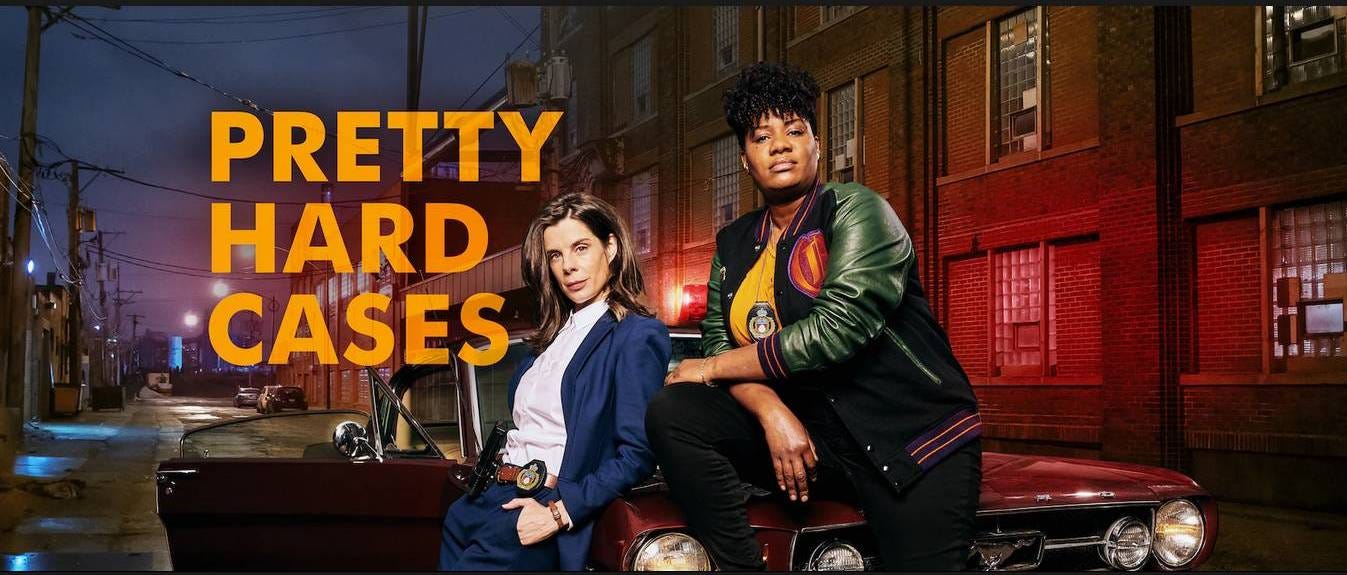Anybody watching Pretty Hard Cases (formerly known as Lady Dicks, a much better title) on CBC Gem and TV? The series shows a lot of promise, but then it squanders it a little in each episode.
Film and TV production in Toronto bounced back from the 2020 lockdown quickly. Like the airline industry, TV production just wouldn’t take no for an answer: it established protocols and continuous on-site testing and bagged some sort of exception from the provincial government early on and was later declared essential service. Filming was modified but it continued and that’s how a new season of Kim’s Convenience for ex and the first of PHC got done over the summer of 2020. (Johanna Schneller of the Globe reported in January ’21 how exactly several TV shows got made while the city’s live performing arts completely shut down.)
So the making of PHC in Toronto, an odd-couple cop show with two female leads, coincided with the summer of the BLM protests after the murder of George Floyd in the US, amidst the defund the police rhetoric, and rising tensions and protests here and globally. Such is the planetary dominance of the US and its media and politics that extremely remote countries that couldn’t be more different from the US also had their own anti-police and anti-black-racism demonstrations in solidarity with black activists in the US. (France is bizarre enough, and UK Labour leader Keir Starmer taking a knee in his office in London, but a BLM walk in Montenegro?!) Soaked in American news, the WFH Toronto progressives also took what was happening in the US personally, and when it transpired that a young woman fell off a balcony in High Park while the police officers were on a 911 call in her family’s apartment, many people grabbed on to the case and declared it Canada’s George Floyd. (It wasn’t.) It was an extremely acrimonious, irrational year in US politics and its acrimony spilled all over the globe and boy did it spill into Canada. Worse, we demanded that spillage straight into our veins. Voices like Coleman Hughes (who would explain on his YT channel that the numbers don’t match the perception and that in fact a minority of fatal police officer vs. unarmed US citizen interactions involved Black people) and Thomas Chatterton Williams (who cogently criticizes the American obsession with racecraft) were not being heard. In the summer of American racial discontent, Toronto’s first black police chief Mark Saunders announced his resignation. Whether he resigned under pressure from activists for not being woke enough, which is how it looked in July 2020, or for some other reason, remains unknown.
When some entertainment media reported that the PHC show runners Sherry White (Maudie, Rookie Blue, Orphan Black) and Tassie Cameron (Mary Kills People, Flashpoint) were influenced by the BLM summer of 2020, I thought Uh oh. Is this going to be a painfully earnest CBC exercise with (morally) black and white characters? I was curious about the show because it had Meredith MacNeill of the Baroness von Sketch, and Adrienne C. Moore of Orange is the New Black, and a talkie trailer in which Toronto is Toronto and not a Generic American City. Now Baroness, while it wrapped up with a cringey, phoned-in final season, is also a show that has changed what sketch comedy can do in North America. MacNeill starred in many of the Baroness sketches which will stand the test of time (the naked selfie, the café washroom, the no-plastic-bag etc.)
Fortunately, the PHC is smarter than black-and-white. There is no, say, a fictional version the High Park tragedy which rewrites the police officers as a guilty party. This is a very diverse Police division, with three lead black characters (one of which is the Unit Commander), one South Asian and a rookie police woman who could be Hispanic. Are Toronto police divisions this diverse? Probably not. But IRL they are more diverse than the defund the police activists are willing to accept.
Each episode has its own storyline which gets solved by the closing credits, and there’s a ongoing story building up episode to episode. We are led to believe early on that the Guns and Gangs’ Sam Wazowski (MacNeill) is by-the-book and Narcotics’ Kelly Duff (Moore) is more creative and rule-bendy if things need doing. To show’s credit, this has nothing to do with race: Duff is loyal to an older (and gruff old school) police officer majestically played by Tony Nappo who, the longer storyline gradually reveals, in a previous Narcotics case beat up a baddie when it wasn’t necessarily called for.
Where the show creators I think got a little careful is in the casting of suspects, criminals and witnesses and I expect this is where the summer of 2020 comes in: they are all roughly white, with the odd East Asian thrown in. Were the show runners reluctant to show cops being rude to a black suspect or witness in interrogation? Let alone roughed up? But it’s only season one: if there will be seasons two and three, Guns and Gangs that only deals with WASPs and East Europeans will be much harder to believe. On the other hand, the “Stockwood” area drug traffickers and dealers from the white lumpen-proletariat stock is perfectly credible and well teased out. The good-for-nothing Dude-like boa-owning blonde himbo Randy Bowen played by Dan Petronijevic, surely I can’t be the only one to think this, brings to mind one Doug Ford and his alleged cocaine-dealing youth. The woman he finds himself working for, played by Tara Strong, single mom with children from two different men and neither one around, kinda looks like Renata Ford. Now of course the Fords are a wealthy family, but their hoser appeal is what gets them the votes. (The tricky class analysis of the Fords I’ll have to put aside for another occasion.) Stockwood could easily be Etobicoke where the Fords operated. Stockwood is the low income and desolate areas of Etobicoke where adolescents smoke pot in school yards, motel rooms hide marital violence and dollar emporiums and fast food establishments double as illicit gun trade spots. In other words, PHC is not doing badly on the questions of class. Many CBC shows are dumb on the class aspect of life – income, work, paying the bills, the fairness or unfairness of the distribution and ownership, the existence of poverty: that tends to be abstracted out from the shows. (Workin’ Moms is one of the egregious examples on current offer, where four women work middle-class jobs but each with a partner owns a $3m+ detached and raises children without any domestic or nanny help. It’s the SATC syndrome: all the necessary Manolo Blahniks on the freelancer rate, in NYC at that.)
The show has other flaws, though. What is the point of the ongoing humiliation of the Wazowski character? The joke about her being too self-conscious and not at all funny and being tin-eared and chronically unable to read the room – is getting very tired. We got it the first few times. Also, the dialogue sometimes strikes a massively false note. “As a cis, white man, of course you got that promotion” says a rookie police officer to her colleague and I wanted to gouge my eyes out. Nobody talks like that outside university classrooms. Nobody says cis. What’s next, Latinx, the word not used by 97 percent of Latinos?
What about the bits which are occasionally dropped because the writers just couldn’t be arsed to tidy them up? Duff and Wazowski end up in a rigged house of a gun maniac in one recent episode, and while Duff is exploring different rooms, a kid appears, Shining-style, and locks her up. Cut. Next scene: Duff is out of that locked room, walking through the hallway, talking to Wazowski, wondering how they can get out of the house. The gun maniac appears, etc etc – no mention of the kid, who conveniently disappeared somehow while his dad tortures two women in his living room. C’mon. Some of us are still awake and watching.
And while many crime show fans don’t get it, I appreciate the screwball side the PHC. There is a lot of talking! And often the banter’s funny. But sometimes it sounds like MacNeill is improvising way beyond the natural conclusion of the scene. And always always the joke is on her. Wazowski is essentially the character MacNeill plays in the Baroness, but thrown intact into dramatic situations. It’s awkward sometimes, worrying that the naked selfie lady suddenly finds herself with a gun pointed at her.
The rest of the cast, especially Moore, Nappo, Strong, Petronijevic, and Susan Kent as Tig’s sister are more at ease in this peculiar mix of comedy and crime. And because of that I am willing to overlook the plotting that occasionally defies belief (eg suspect’s teen daughter befriending Wazowski’s son and eavesdropping as Wazowski summarizes for Duff how and when the police intend to surround the stash house).
There are two more episodes this season, so let’s see where they takes us.
LP
Quick links:
Why does the murder of a US citizen spark demonstrations around the world, and an ongoing persecution of an entire ethnic group in China none whatsoever? A recent episode of my favourite history podcast, Rest is History, is on Americanization.
“Away from the studio and the sold-out stadiums and her social media safe spaces, where her fans rival the QAnon kooks for unhinged devotion, her skin is thinner than graphene.” Make a joke about Taylor Swift at your own peril.




